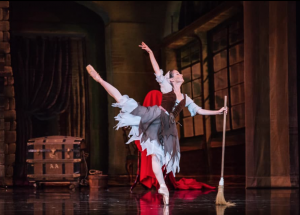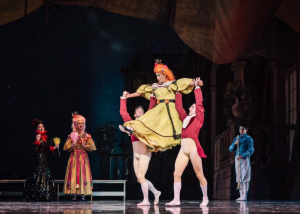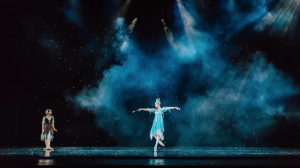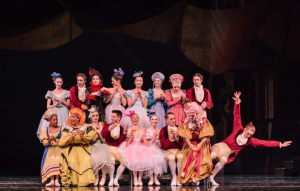Jared Nelson Creates a Cinderella Story for California Ballet
“Cinderella” was an inspired choice for Jared Nelson’s first evening-length work as artistic director of California Ballet. The ballet, which premiered last weekend, continues the company’s tradition of going with classics that have family appeal and can fill the Civic Theatre. And, like Cinderella shaking off the ashes and emerging as a princess, Nelson’s dynamic choreography and sense of fun promise to reinvigorate the 50-year-old company’s sometimes-musty repertory.
 Reka Gyulai as Cinderella (in the Friday cast) captivated from her first moment onstage, in a yearning adagio pas de deux, as if she and the prince are dreaming of each other. She displayed quick footwork and airy jumps, picking up steps from a dancing master (Levi Durie) who’s teaching her stepsisters. And she was an ebullient belle of the ball, dazzling in extended balances and traveling pirouettes.
Reka Gyulai as Cinderella (in the Friday cast) captivated from her first moment onstage, in a yearning adagio pas de deux, as if she and the prince are dreaming of each other. She displayed quick footwork and airy jumps, picking up steps from a dancing master (Levi Durie) who’s teaching her stepsisters. And she was an ebullient belle of the ball, dazzling in extended balances and traveling pirouettes.
Zachary Guthier’s Prince Charming gave her strong support in sometimes-tricky lifts, as well as superb emotional partnering—I had no trouble believing the prince and Cinderella were in love. In solo turns, Guthier was clean if not thrilling. (Gyulai and Guthier alternated with Ana da Costa and Trystan Merrick.)
 The stepsisters were played by men, a tradition that began with Frederick Ashton’s 1948 version; and Oscar Burciaga and Stephen Hallburn, in orange and pink wigs respectively, vamped up a hilarious storm. In the ball scene, Burciaga’s drumming feet parodied flamenco, and Hallburn did a gawky cartwheel.
The stepsisters were played by men, a tradition that began with Frederick Ashton’s 1948 version; and Oscar Burciaga and Stephen Hallburn, in orange and pink wigs respectively, vamped up a hilarious storm. In the ball scene, Burciaga’s drumming feet parodied flamenco, and Hallburn did a gawky cartwheel.
In other major roles, Jeremy Zapanta as the Jester stole every scene he was in, with through-the-roof split jumps, powerful fouettés (turns where one leg whips in and out), and his sheer joy. Megan Wilcox was a sparkling Fairy Godmother. Clearly, magic was in the air when her entrance brought vividly-costumed fairies, fauns, sylphs, unicorns, and tiny bumblebees onto the stage. The costumes were designed by Nanette Morone, Theresa Kinbrough, E. Virginia Williams, and Nancy Daly.
 Miranda Giles executed assured fouettés as the Fairy of Winter, and Emma Sherman was a fleet-footed Autumn Fairy, as well as a hyper-mobile Arabian Princess in the character dances in Act II. In the original Bolshoi Ballet production of 1945, the fairies of each season brought Cinderella gifts; Nelson didn’t do this, and it was a departure from tradition that I regretted.
Miranda Giles executed assured fouettés as the Fairy of Winter, and Emma Sherman was a fleet-footed Autumn Fairy, as well as a hyper-mobile Arabian Princess in the character dances in Act II. In the original Bolshoi Ballet production of 1945, the fairies of each season brought Cinderella gifts; Nelson didn’t do this, and it was a departure from tradition that I regretted.
One of the great charms of Nelson’s “Cinderella” is the care he lavished on every moment of the ballet. Even minor characters had a signature presence, and there was no filling up musical phrases with simply striding around, doing mime.
The stepmother (Amanda Daly) did a frantic, jerky, “I’m getting old and losing my looks” dance in front of a mirror, to agitated strings in the Prokofiev score (in a recording by the London Symphony). The messenger bringing news of the prince’s ball (Swovelin) cavorted and leaped. Durie, as the dancing master, performed en pointe, with a lifted posture that seemed to surpass what’s possible for the human spine.
 In the ballroom scene, Nelson gave the corps some of the choicest comedic moments. Partnering the women, the men leaned slightly back in a campy spoof of elegance. Dating from the original Bolshoi production, the ballroom scene has included a gift of oranges; Nelson turned this into a wonderfully goofy bit with the dancers in two tiers facing us, passing oranges to one another, and doing a merry circle dance holding their oranges aloft.
In the ballroom scene, Nelson gave the corps some of the choicest comedic moments. Partnering the women, the men leaned slightly back in a campy spoof of elegance. Dating from the original Bolshoi production, the ballroom scene has included a gift of oranges; Nelson turned this into a wonderfully goofy bit with the dancers in two tiers facing us, passing oranges to one another, and doing a merry circle dance holding their oranges aloft.
Nelson’s second season begins in the fall and includes plans for a brand-new “Nutcracker.” Based on his splendid “Cinderella,” this should be a much-anticipated holiday treat.
